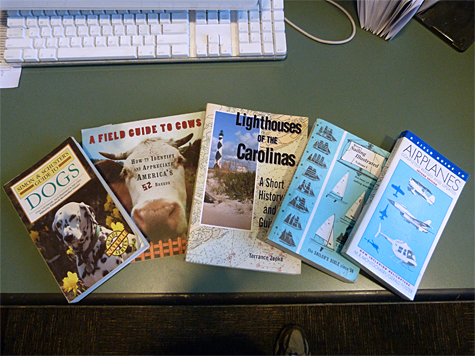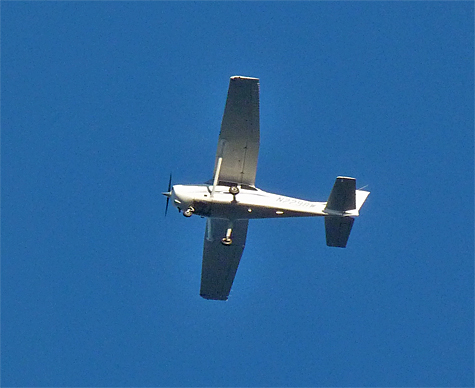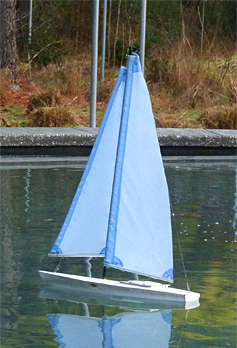There seems to be a guide to just about anything and everything. Whatever it is you happen to be looking at someone has put together a guide to help you figure out what it is, and often, how it relates to the world. There are field guides to birds, mammals, insects, reptiles and amphibians, plants and trees.
Bird guides are further broken down into eastern birds, western birds, and even groups of birds: sparrows, shorebirds, raptors, warblers, owls. There are guides to marine mammals. There are guides to orders of insects like grasshoppers, katydids, and crickets, dragonflies, butterflies, beetles, and more. The list goes on and on.
I have several bookcases devoted to nothing but guides to various creatures and other “things.” I have guides to help me identify things such as breeds of dogs, cows, lighthouses, sailboats, and airplanes and helicopters.

You never know when you’re going to come across something that you haven’t seen before. I don’t know about you, but when something new pops into view I can’t help but wonder what it is. I may not immediately seek the answer to the puzzle, but the question usually remains somewhere in the back of my brain for further investigation. By the way, I’m never bored while driving down the road, there’s always something new to see.
The guide to dogs that I have lists more than 320 breeds from Affenpinscher to Yugoslavian Tricolor Hound. Good field guides not only physically describe the subject matter but give a history and or origin of the subject being described, and my dog guide does that and more. Is the dog you’re contemplating gentle, have a tendency to bite? Is it a rescue dog, a guide dog? Can the dog be trained for defense, is it a hunter, a water dog, cow herder, retriever? Does your dog need clipping, will you have to put a coat or sweater on the dog in winter? Did you know that the familiar Bloodhound breed is more than a thousand years old and was created by the monks of St. Hubert in Belgium?
Imagine driving through cattle country, any road in Kansas, down Highway #27 in Florida between Orlando and Lake Okeechobee, or along Route #64 west of Pittsboro here in North Carolina. On your left and right you see fields and pastures with large black, sometimes white, sometimes brown, or even white, black and brown together, animals standing around in those fields and pastures. They’re cattle, yes, but what kind? Are they beef cattle, dairy cattle, or are they multipurpose cattle? Do the cattle have long sweeping horns, or no horns at all? Do they have long fur or short?
Fifty-two breeds are identified, described as to purpose, and given background histories in A Field Guide to Cows. Everything from the Africander to the Zebu are described. And yes Holsteins, Jerseys, and Galloways are included. By the way, Max of Museum of Life and Science Farmyard fame is a Jersey. But, you probably already knew that.
Many years ago I stood on a bunker at the Sandy Hook Unit of Gateway National Recreation Area in New Jersey. Elevated above the surrounding landscape with a commanding view in all directions, I was there to watch hawks stream north during spring migration. Sandy Hook is a spit of land that juts out into Raritan Bay and is directly across from New York City. The Statue of Liberty, Manhattan, and parts of Long Island are visible from the bunker.
There are numerous airports in the area, LaGuardia, JFK, Newark, and a host of smaller commercial and private airports. As you can imagine, the air traffic is constant, and it comes and goes from all over the world. I’d seen everything from Piper Cubs to the now out of commission Concord from the hawk watch at Sandy Hook. It was there, on that sandy spit of land atop a sandy mound of dirt that I first decided that I needed a field guide to airplanes.
We don’t have as many airports or as much air traffic here at the Museum, but you might be surprised at how many and what kind of aircraft I spot each day. RDU is an international airport, and there are many smaller airports close by. And don’t forget Greensboro, 50 some short air miles to the west.
I doubt that I would have ever known that a Bombardier Dash 8 Q400 passed over the Museum’s airspace on December 13 and 21 of last year had I not had a guide to planes. The Q400 Dash 8 is a high-speed commuter turbo prop plane. The one that I was able to photograph over the Museum showed Continental’s colors on her tail (I thought they merged with United?).

How would I have known that a Cessna 172 passed over the other day had I not had a field guide?

I’m sorry, though, that I didn’t have my camera at the ready when a pusher-prop plane went over a few weeks back. You know, one of those experimental planes with the propeller in the rear that pushes instead of pulls the plane through the air. I wasn’t quick enough to catch that unique looking aircraft as it roared over the Museum.
During one year towards the end of the nineties I visited 29 different lighthouses. I don’t think I would have been able to do that without a guide in hand. North Carolina has eight easily seen lighthouses all worth visiting. One, however, can only be seen from the Southport Ferry, is only a couple of dozen feet in height, and does not have a light. That small lighthouse is on your left as you leave the Southport Ferry terminal at the mouth of Price’s Creek.
Lighthouses are always located near water and there’s always birds, dragonflies, butterflies and many other interesting creatures and historical attractions to keep one busy on your way to and from the lights. And guess what, the lights’ proximity to water usually means that there are seafood restaurants nearby!

We have sailboats here at the Museum. Yes, the boats are only models, but they’re modeled after something. Thanks to my handy guide I now know that the hulls of the boats most closely resemble the Windward Passage design. The rigging, definitely masthead-rigged sloop.
Guides are, by definition, only guides. They’re meant to get you to a certain point whether that point be a physical or mental location or place. Once you get to that point it’s up to you to decide whether or not to go further. I must say though, that it’s usually the journey that’s the most exciting, the discovery of new things along the way, and a guide will usually get you on your way to those discoveries.
By the Way, one field guide on my bookshelf has a bit of movie trivia associated with it, Birds of the West Indies by ornithologist James Bond. Did you notice the author’s name, James Bond? It turns out that Ian Fleming, author of the 007 spy novels (Casino Royale, Goldfinger, etc.), was a bird watcher, lived in Jamaica, and owned a copy of Bond’s book. Fleming borrowed the bird guide author’s name for his now famous 007 character.
Jennifer and I agree that there should be a field guide for field guides.
And so there is,
“A Guide to Field Guides: Identifying the Natural History of North America (Reference Sources in Science and Technology)”
although it only covers natural history field guides.
And here I was thinking I was the only person with a field guide to cows and a cow life list and a color identifier chart for bovines…I LOVE this article on field guides as it is exactly how I view the world – so many things are so interesting! Thanks!!
You’re not alone out there Frances, you’re not alone.
I don’t have a color guide to cow coloration but I do have one for birds. I can’t remember the name of it (I’m not at home right now) but I used it to help describe birds captured during the process of banding them.
Have a good one!